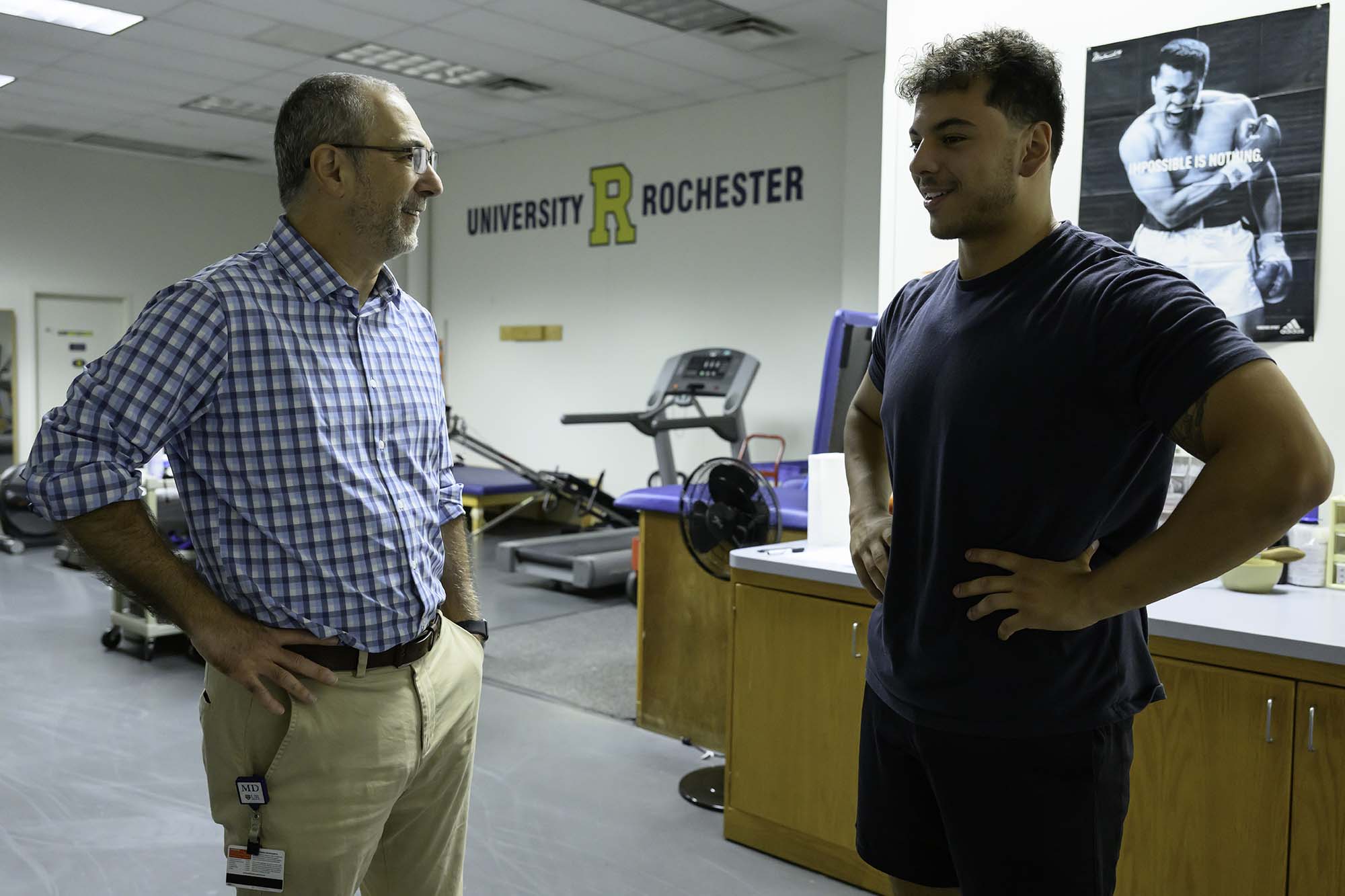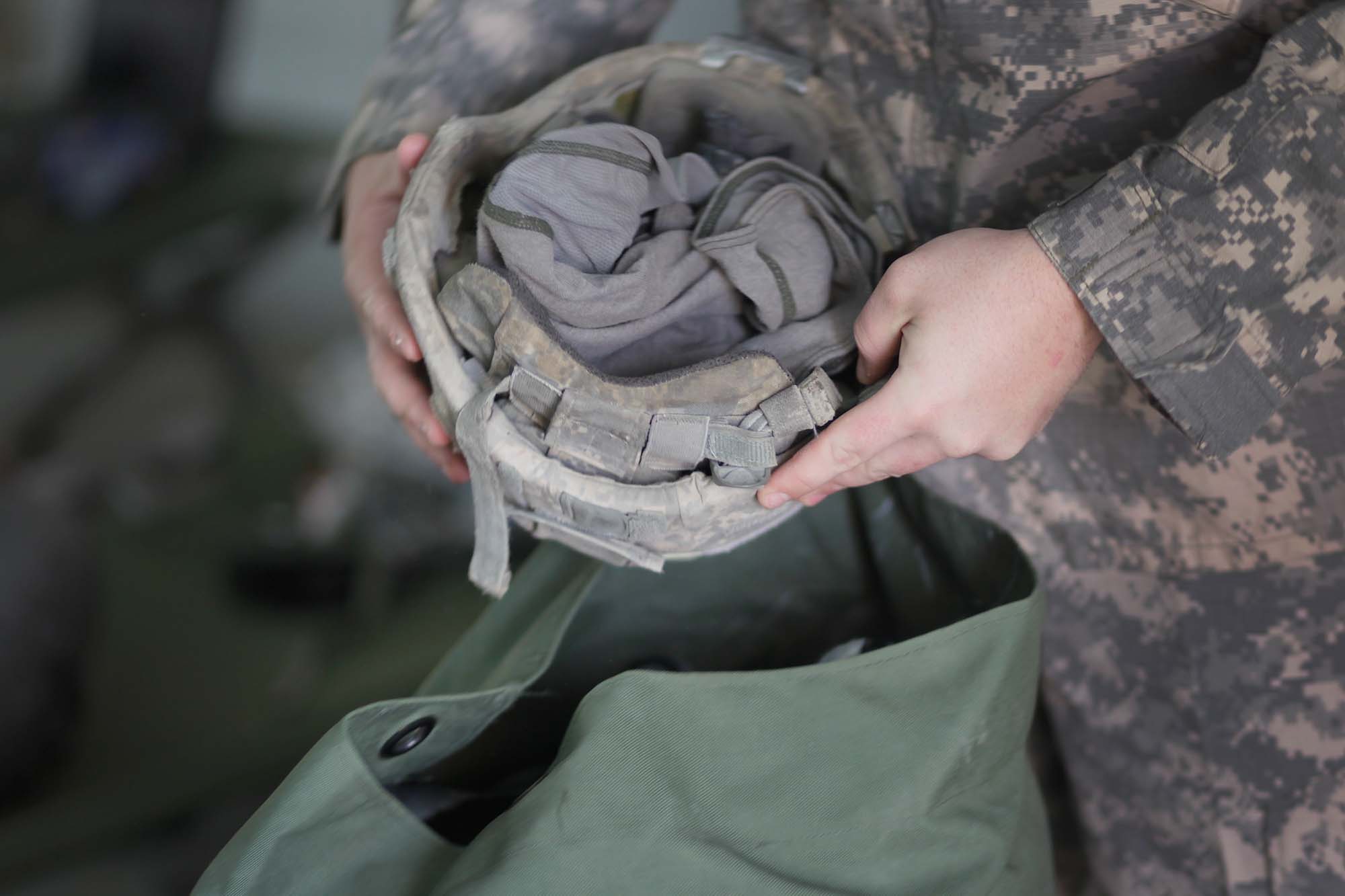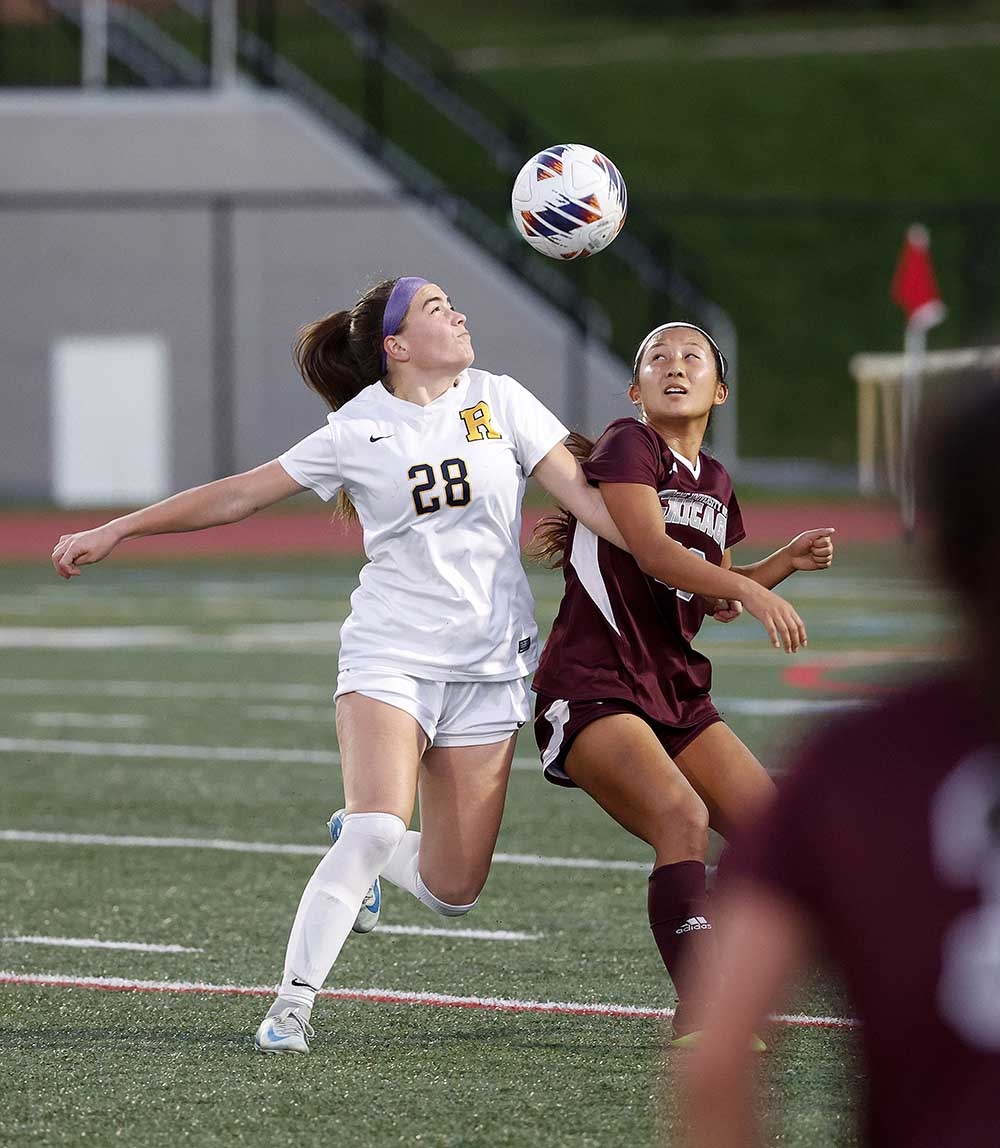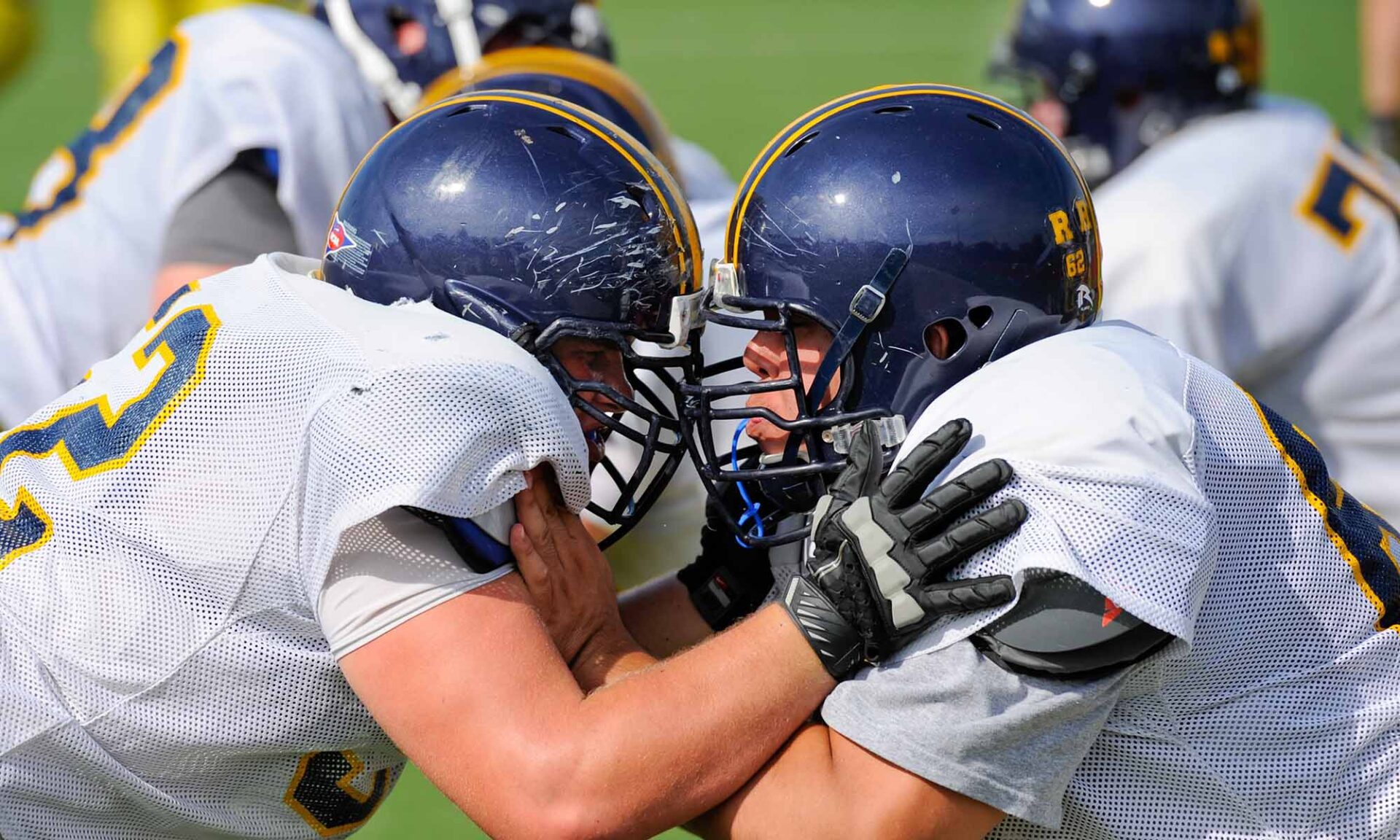From the sidelines to the front lines, Rochester research is redefining how concussions are detected, treated, and prevented.
Once, twice, three times a head hit.
How many are too many? How could a traumatic brain injury be diagnosed with minimal or no outward symptoms? What’s the lasting impact of a mild traumatic brain injury or concussion?
According to the Centers for Disease Control, millions of people suffer traumatic brain injuries (TBIs) each year. While most are caused by accidents or falls, many are the direct result of sports injuries. In the last several years, how the brain responds to a concussive head hit and to repeated sub-concussive hits, particularly during a sporting event, has shifted. Researchers at the University of Rochester Medical Center have been at the forefront of concussion and traumatic brain injury discoveries, resulting in updated rules and protocols in sports like soccer and football.
Jeffrey Bazarian, a professor of emergency medicine and of neurology at Rochester, has dedicated his career to improving the detection and treatment of traumatic brain injuries—particularly those on the lower end of the severity spectrum, which are more likely to be overlooked. That work has not only benefited the scientific community, but also the people most likely to experience the effects of concussions and other head injuries.

Case in point: Nearly 10 years ago, Bazarian and Edwin vanWijngaarden, a professor of public health sciences at the University, recommended that return-to-learn should be considered just like return-to-play for high school and college-aged students after a concussion. Their research findings showed that academic problems were more frequent at one week after concussions compared to the students with other types of sports injuries. Today, the CDC’s HEADS UP program provides schools with guidelines on how to work with students after a concussion.
Bazarian continues to work with student-athletes, this time as the leader of a multisite study funded by the Department of Defense (DOD) to detect subtle neurologic dysfunction after repetitive head hits—many of which don’t result in obviously outward injury—and to develop treatments to mitigate this dysfunction. He is also a site investigator for another multisite study, this one supported by the National Institute of Neurological Disorders and Stroke (NINDS), to study the effects of concussions on children, including how this injury impacts the developing brain of youths and adolescents.
And so, study by study, researchers like Bazarian and his colleagues at the University are bringing clarity to the big questions of how trauma and injuries—one-off and repeated—can affect the human brain and overall health and well-being across the lifespan.
The hidden dangers of repetitive head hits
Each hit to the head can compound the one before—sometimes without symptoms to warn of a growing injury. When a person’s occupation or activity exposes them to repeated head hits—like members of the military or athletes—they can experience subtle declines in neurologic function, such as balance, eye movements, and rapid decision making.
These declines in neurological function are not currently detectable by a doctor but can nonetheless impair athletic or military performance and increase the risk of sustaining other injuries. In the long run, such repeated head hits may contribute to the development of serious neurodegenerative diseases or disorders. However, unlike concussion, there is no current standard of care to track, prevent, or treat these hits.
Bazarian is at the front lines of efforts to address that gap.

This fall, he’s recruiting football players at the University of Rochester, University at Buffalo, Indiana University, and the Citadel military college. The aim? To track the subtle changes that occur because of sports-related head hits in student-athletes in order to better understand the early indicators of repetitive injuries and what the response protocol should be. The researchers hope to add female soccer players to the research project next year. This would provide critical insight into the impact these head hits have on the female brain, since previous work has only included male subjects.
“We’re trying to determine if we can detect and mitigate the acute effects of exposure to repetitive head hits on the brain,” says Bazarian. “Do these hits alter neurologic functions in a way we can pick up using objective measures suitable for use in low-resource environments like battlefields and athletic fields? If so, what can be done to return neurologic function back to baseline as quickly as possible?”
Bazarian received the aforementioned grant from the DOD’s Army Medical Research Acquisition Activity (ARMY MRAA), a congressionally directed medical research program, to better understand these repetitive hits to the head, with goals to find ways to detect, prevent injury, and treat them.

“In a sense, we are borrowing from the field of occupational medicine by applying a brain health monitoring approach to individuals exposed to an environmental factor, in this case repetitive head hits, that increases their risk for neurologic injury,” he says. “Our hope is that one day this approach will lower the long-term risk of neurodegeneration in those exposed.”
Blood tests for brain health
Recently, Bazarian joined nearly 100 clinicians and researchers from around the world to propose the first revision to how TBIs are classified since 1974, when the current diagnostic method known as the Glasgow Coma Scale was established.
The new method of characterizing TBI replaces the standard categories of “mild,” “moderate,” and “severe,” with descriptors in four domains: Clinical, Biomarkers, Imaging, and patient Modifiers (CBI-M). This new characterization approach was recently described in The Lancet Neurology and Journal of Neurotrauma.
Decades of research in Bazarian’s lab has produced groundbreaking discoveries in how the blood can inform brain health. Specifically, the researchers have identified a technique that measures three brain proteins that can appear in the blood within hours of a brain-injuring head hit—glial fibrillary acidic protein (GFAP), ubiquitin carboxy-terminal hydrolase L1 (UCH-L1), and S100 calcium-binding protein B (S100B).
The levels of these proteins can provide unique insight into the magnitude of brain injury that was not previously available to clinicians. High levels can predict six-month mortality and incomplete recovery, while low levels indicate an extremely low risk of a brain bleed on CT scan, which would inform whether a CT scan is necessary.

In 2018, the Food and Drug Administration approved a blood test called the Banyan Brain Trauma Indicator. The University’s Medical Center was a site for one of the test’s clinical trials, with Bazarian as the lead author of a related study that appeared in the journal The Lancet Neurology. That work proved influential as part of the FDA’s decision to approve the first blood-based biomarkers of traumatic brain injury in the United States.
Recruiting subjects for this research, Bazarian and his fellow researchers work with University of Rochester student-athletes and patients in the Strong Memorial Hospital Emergency Department. They also collaborate with Kian Merchant-Borna, an associate professor of emergency medicine at Rochester, to follow these subjects through their recovery. Beyond the initial diagnosis, a person is generally monitored based on what symptoms they have–subjective markers like patient-reported symptoms such as headaches, nausea, or light sensitivity.
“Not knowing what is happening in the brain can affect an individual’s quality of life in the long term,” Merchant-Borna says. “Concussion recovery can be difficult to track, and symptoms often dissipate before the brain is fully healed.”
The University of Rochester’s concussion research is more than a series of studies—it’s a sustained effort to safeguard brain health across the lifespan. In pushing the boundaries of what medicine can know and do, Rochester is leading the way toward a future where the complex dangers of head injuries are better understood, better treated, and ultimately, better prevented.





